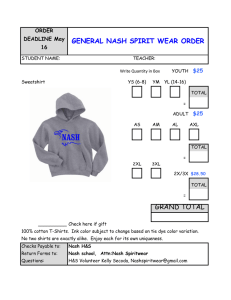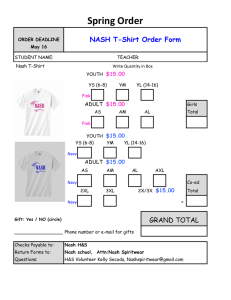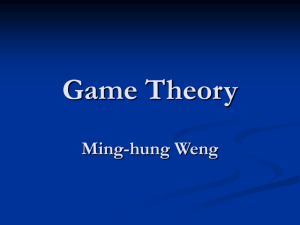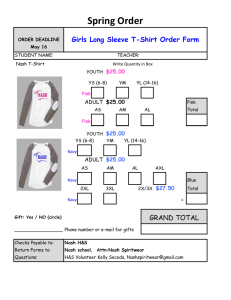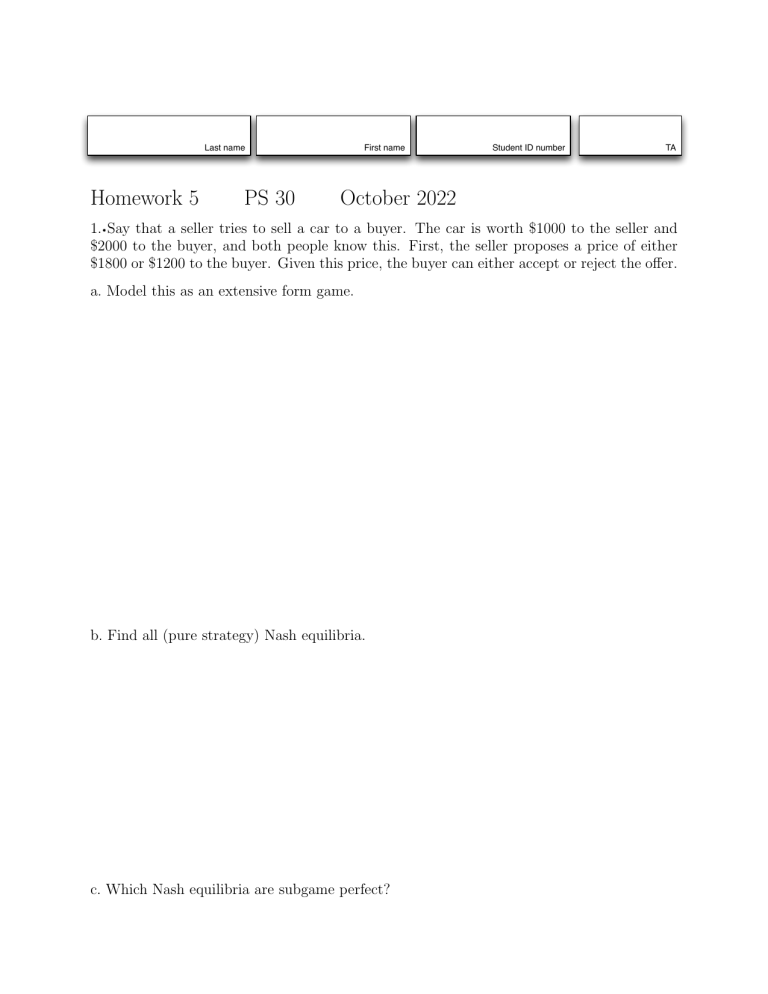
Last name Homework 5 PS 30 First name Student ID number TA October 2022 1. Say that a seller tries to sell a car to a buyer. The car is worth $1000 to the seller and $2000 to the buyer, and both people know this. First, the seller proposes a price of either $1800 or $1200 to the buyer. Given this price, the buyer can either accept or reject the offer. a. Model this as an extensive form game. b. Find all (pure strategy) Nash equilibria. c. Which Nash equilibria are subgame perfect? 2. Say that you and your brother divide up 4 oranges in the following manner. First, you divide the oranges up into two piles: the left pile and the right pile. For example, you could put one orange in the left pile and three in the right pile. Then, your brother decides which of the two piles he wants; he keeps that pile and you get the other pile. Both of you like oranges. a. Model this as an extensive form game and find the subgame perfect Nash equilibria. How will the oranges be divided? 3. Say that country A can either attack or not attack country B. Country B cannot defend itself; the only thing it can do is to set off a “doomsday device” which obliterates both countries. The worst thing for both countries is to be obliterated; for country A, the best thing is to attack and not be obliterated; for country B, the best thing is to not be attacked. a. Think of country A moving first and model this as an extensive form game. Find all pure strategy Nash equilibria and find the subgame perfect Nash equilibria. b. Now think of country B moving first and model this as an extensive form game. Find all pure strategy Nash equilibria and find the subgame perfect Nash equilibria. 4. The game called “Nim” goes like this: there are a pile of five stones on the ground. Player 1 can take either 1 or 2 stones. Then player 2 can take either 1 or 2 stones. They continue taking either 1 or 2 stones in turn until all the stones are gone. The player who takes the last stone (or stones) wins. a. Model this as an extensive form game and find the subgame perfect Nash equilibria. b. What happens when you start with n stones instead of five? 5. Say we have a version of the “centipede” game. Each person can either move “down” or “across.” 1 a 2 a 1 a 2 d d d d 2, 2 1, 8 4, 4 2, 16 a 8, 8 Just to be clear, the game goes from left to right. First, person 1 chooses whether to play d or a. If she plays d, then the game ends and both players get 2. If person 1 plays a, then person 2 chooses between d or a. If person 2 chooses d, then person 1 gets 1 and person 2 gets 8. If person 2 chooses a, then person 1 gets to choose between d and a, and so forth. a. Find the subgame perfect Nash equilibrium. b. Represent this game in strategic (matrix) form. c. Solve this strategic form game using iterated elimination of weakly dominated strategies. Show the order of elimination. 6. [from Spring 2004 midterm] Person X and Person Y are on a 7 day cruise, which starts on Monday and goes until Sunday. Both know that this cruise is their last hurrah. Both know that once Sunday comes around and the cruise ends, if they are still together, the game ends because Person X will be forced to dump Person Y (because otherwise Person X would be disowned by their wealthy parents). On Monday evening, Person X decides whether to break up or continue in the relationship. If Person X decides to continue, then on Tuesday evening, Person Y decides whether to break up or to continue. If Person Y decides to continue, then on Wednesday evening, Person X decides whether to continue. The game continues like this, with Person X and Person Y taking turns deciding whether to continue or to break up (Person X gets to decide on Monday, Wednesday, and Friday, and Person Y decides on Tuesday, Thursday, and Saturday). If anyone decides to break up, the game is immediately over. If no one decides to break up, then they make it to Sunday, and Person Y is left heartbroken. Each person enjoys the other’s company, and gets a payoff of 5 for every day the relationship continues. However, no person wants to be dumped; if a person breaks up the relationship, the other person (the dumped one) gets -10 added to their payoff. For example, if they make it all the way to Sunday, Person X’s payoff is 35 and Person Y’s payoff is 25. a. Represent this as an extensive form game. b. Find the subgame perfect Nash equilibrium. 7. [from Spring 2002 midterm] Consider the “cross-out game.” In this game, one writes down the numbers 1, 2, 3. Person 1 starts by crossing out any one number or any two adjacent numbers: for example, person 1 might cross out 1, might cross out 1 and 2, or might cross out 2 and 3. Then person 2 also crosses out either one number or two adjacent numbers. For example, starting from 1, 2, 3, say person 1 crosses out 1. Then person 2 can either cross out 2, cross out 3, or cross out both 2 and 3. Play continues like this. Once a number is crossed out, it cannot be crossed out again. Also, if for example person 1 crosses out 2 in her first move, person 2 cannot then cross out both 1 and 3, because 1 and 3 are not adjacent (even though 2 is crossed out). The winner is the person who crosses out the last number. a. Model this as an extensive form game. Show a subgame perfect Nash equilibrium of this game by drawing appropriate arrows in the game tree. b. Now instead of just three numbers, say that you start with m numbers. In other words, you have the numbers 1, 2, 3, . . . , m. Can person 1 always win this game? (Hint: look at m = 4, m = 5, etc. first to get some ideas.) 8. Read “It’s Not Just About Bonds, It’s About Who’s on Deck” by Jack Curry on the “Media Clips” website. Model the situation using extensive form games and use the games to show that who bats behind Barry Bonds influences a pitcher’s decision of how to pitch to Bonds. 9. Richard Nixon subscribed to a foreign-policy principle which he called the “madman theory” or the “theory of excessive force” (see “The Trials of Henry Kissinger” on the Media Clips website, or read “Nixon’s Nuclear Ploy” by William Burr and Jeffrey Kimball, also on the Media Clips website). We will explain this theory using an extensive form game. Say that the US is facing an adversary (for example North Vietnam). The US makes the first move: it can either threaten North Vietnam or do nothing. If the US does nothing, then the game ends and “nothing happens.” If the US makes a threat, North Vietnam can either comply or not comply. If North Vietnam complies, then the game ends. If North Vietnam does not comply, then the US can either strike militarily or not. a. Say the payoffs are like this: if the US does nothing, then both get payoff 0. If the US threatens and North Vietnam complies, then the US gets payoff 10 and North Vietnam gets payoff -5. If the US threatens, North Vietnam does not comply, and the US strikes, then the US gets payoff -10 and North Vietnam gets payoff -10. If the US threatens, North Vietnam does not comply, and the US does not strike, then the US gets payoff -5 and North Vietnam gets payoff 10. The idea here is that the best thing for the US is for the US to make a threat and North Vietnam to comply; this way the US doesn’t have to perform the military strike. The worst thing for the US is to have to perform the military strike, since this would risk expanding the war. The best thing for North Vietnam is to openly defy the US and “call the bluff” of the US; the worst thing is the military strike. The second-worst thing is to comply to the US threat, and the second-best thing is to not be threatened at all. Model this as an extensive form game and find the subgame perfect Nash equilibrium. b. Now say that Nixon, by purposefully showing the world that he is a “madman,” convinces everyone that the US payoff from a military strike is 5, not -10. In other words, Nixon tells the world that as far as he is concerned, he would enjoy a military strike. Model this as an extensive form game (all other payoffs are the same) and find the subgame perfect Nash equilibrium. c. Compare the two situations and explain why Nixon wants to show the world that he is a “madman.” 10. Say we have two basketball players, Nash and Yao. Nash has the ball 20 feet from the basket and Yao is defending. Nash can either take a jump shot or drive the basket. Yao can either come out and contest the shot, or can stay in and protect the basket. The game looks like this. Yao comes out Yao protects Nash takes jump shot 0.3, 0.7 0.4, 0.6 Nash drives 0.5, 0.5 0.3, 0.7 For example, if Nash takes a jump shot and Yao comes out, then Nash has a 30 percent chance of scoring and Yao has a 70 percent chance of successfully defending. a. Find the mixed strategy Nash equilibrium of this game. In the mixed Nash equilibrium, what is Nash’s overall probability of scoring? b. Now say that Nash practices over the summer and improves his jump shot. Now the game looks like this. Yao comes out Yao protects Nash takes jump shot 0.4, 0.6 0.5, 0.5 Nash drives 0.5, 0.5 0.3, 0.7 Find the mixed strategy Nash equilibrium of this new game. In the mixed Nash equilibrium, what is Nash’s overall probability of scoring? c. After Nash improves his jump shot, does he go to his jump shot more often? After Nash improves his jump shot, is it more successful? After Nash improves his jump shot, is his drive more successful? Why does an improved jump shot improve other parts of Nash’s game?


